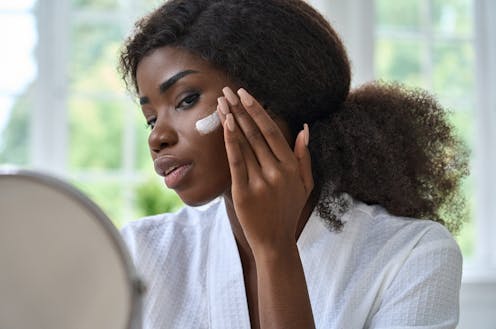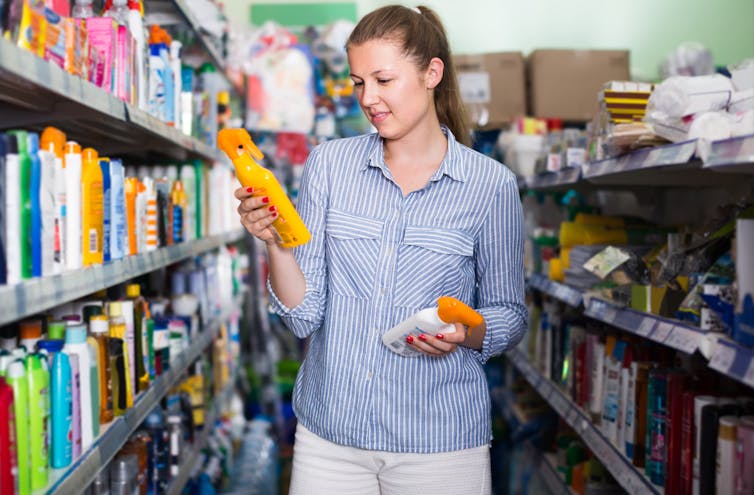
Every month there seems to be a trendy new product to add to your skincare collection. Lately, a commonplace product that many people already use has taken the top spot, with everyone from dermatologists to influencers swearing by it as the number one way to stay looking youthful through the years: sunscreen.
It’s no wonder. It’s thought that solar exposure – also known as “photoageing” – causes up to 80% of skin ageing. So if you’re someone who’s worried about fine lines, wrinkles and uneven pigmentation, limiting the amount of solar radiation you get is one of the most important things you can do.
There are thought to be a number of different triggers for photoageing. Most research has linked it to the expression of a group of proteins called matrix metalloproteinases (MMPs). These proteins are enzymes that break down elastins and collagens in the skin’s deeper layer (called the dermis). Elastins and collagens are responsible for the skin’s structure, strength and stretchiness.

This article is part of Quarter Life, a series about issues affecting those of us in our twenties and thirties. From the challenges of beginning a career and taking care of our mental health, to the excitement of starting a family, adopting a pet or just making friends as an adult. The articles in this series explore the questions and bring answers as we navigate this turbulent period of life.
You may be interested in:
Do these three popular anti-ageing skincare ingredients work? Here’s what the evidence says
Why you should travel solo this summer
Should I still go on holiday if I have COVID?
Expression of these MMP proteins has been linked to both DNA damage in skin cells and the production of reactive oxygen species. Reactive oxygen species are highly reactive chemicals formed from oxygen that can damage other cellular components, such as DNA and proteins.
Both of these factors are caused by too much sun exposure. Over time, this damage accumulates to cause characteristic signs of ageing. This may explains why one study even showed people who tended to avoid the sun had significantly fewer signs of ageing compared to people who enjoyed spending time in the sun.
But it isn’t always possible to avoid the sun – which is where sunscreens help. These products contain ingredients (such as zinc oxide) which absorb or reflect UV radiation and dissipate it safely before it can damage our skin cells. This also reduces the cumulative dose of radiation received by the skin.
Studies have shown that sunscreens can prevent many signs of photoageing by tackling the triggers, with numerous studies showing they can prevent the expression of MMPs. A study that compared the effects of using sunscreen versus a placebo on skin ageing, found that people in the placebo group had higher levels of solar elastosis (a sign of photoageing which causes a loss of elasticity) after two years.
An Australian study compared levels of photoageing in groups assigned to daily sunscreen use versus discretionary sunscreen use. In the daily sunscreen use group, there was no detectable increase in skin ageing over the four-and-a-half year study period compared to the discretionary sunscreen group. Another study has also shown daily sunscreen use for a year may reverse visible signs of ageing when assessed by a dermatologist.
Choosing the right product
While there is plenty of evidence that sunscreens can prevent photoageing, many only block the UV (ultraviolet) range of the solar spectrum. In the case of photoageing, exposure to visible radiation (particularly blue light) and infrared have all been shown to contribute to photoageing. Basically, this means that sunscreens can’t protect against photoageing entirely, but can reduce it significantly.

Some newer solar filters used in sunscreens have been developed which can block some blue light. Other ingredients sometimes added to sunscreens (such as antioxidants) have also been shown to prevent the production of MMPs and reduce reactive oxygen species – which will likely help in the fight against photoageing beyond the UV spectrum, too. Antioxidants may also protect against factors such as pollution and smoking, which are both linked to faster ageing.
Photoageing is a cumulative process that occurs over time. Doing anything you can to limit exposure will slow this process – such as covering up with clothing when you go outside. But choosing the right kind of sunscreen may also help somewhat.
The best product to use comes down largely to personal preference. But in general, the higher the SPF, the greater protection you’ll have against photoageing. You should also try to find a sunscreen with five-star UVA protection on the label, which will help protect against the broadest range of UV radiation.
Be sure to regularly use sunscreen or SPF-containing products from spring to autumn. If you’re going to be getting a lot of sun (such as on a beach holiday) it’s best to use a higher SPF product and reapply regularly. Although some people recommend wearing sunscreen even in winter, this is unlikely to be of much benefit to people living in the UK, as UV radiation is lowest this time of year. But if you go on a skiing holiday or live somewhere with lots of snow, sunscreen will still be beneficial as snow reflects solar radiation.
All the evidence suggests that by far the most effective way to prevent photoageing is with the use of sunscreens, as these prevent damage from happening in the first place. Now with more choice than ever and formulations always being improved, it’s just a matter of finding what product works best for you.
But a final word of warning: slathering on sunscreen before sitting out tanning won’t be enough to protect you completely – and this goes beyond photoageing. Too much sun exposure can carry other risks – such as sunburn and skin cancer – which is something to bear in mind during the summer months.
Karl Lawrence has previously received funding from the sunscreen industry.
This article was originally published on The Conversation. Read the original article.







